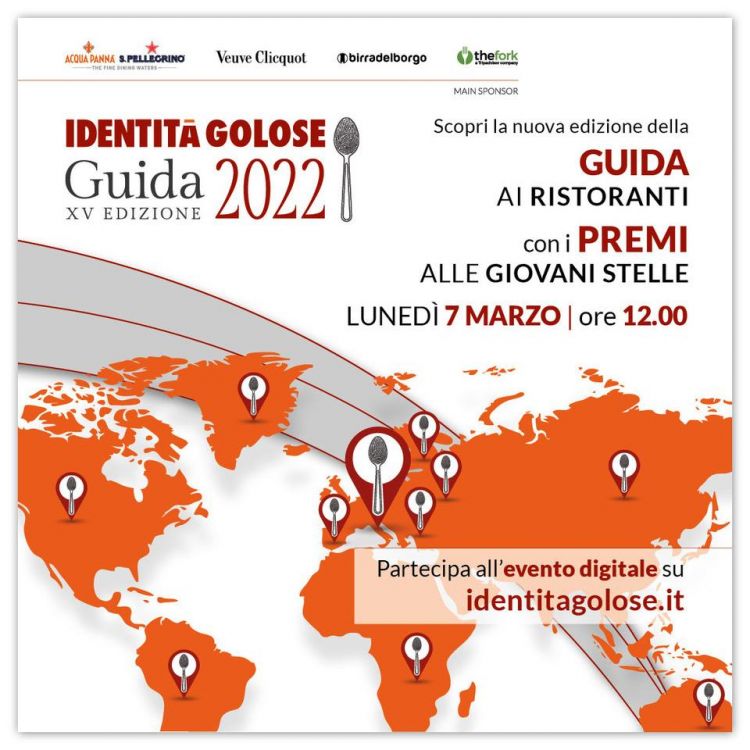The guide in a nutshell? I'll use two numbers: 227 and 1055. The 2022 edition of the Guida di Identità Golose ai ristoranti di Italia, Europa e Mondo can be summed up by these two numbers which are not carved in marble because an online publication guarantees an elasticity that is unknown to those who are still obstinately publishing a printed one. This year we have 1055 reviews, of places in Italy and abroad, from 31 different countries. Last year we had 828, hence 227 less. The world was shut because of the pandemic and with Gabriele Zanatta coordinating the beautiful roster of collaborators, we only focused on top Italian restaurants, with countless difficulties because movements were very limited.
Thanks to vaccines we're travelling once again, and we acknowledge that a certain way of conceiving fine dining that was meant for the super-rich, with prices pumped up by the wealth of few people is wavering. There have always been places that were inaccessible to most, but never as now. We all know that the price of a dish or of a whole menu is only partially based on the cost of raw materials, but those who had the main goal of satisfying the multimillionaires of every country, though not only them, had also chosen not to consider the passionate and sincere food lovers, who were ready to spend a significant amount as long as their money was considered with intelligence and respect.
Russia's invasion of Ukraine might have given a formidable blow to this system that strongly reminds us of a house of cards, a rise without any authentic foundations, realities of extraordinary beauty and importance that were hardly (and still are so) a showcase for the agricultural and culinary cultures of the countries in which they were born. It was all about ego, a very strong adulation of the ego of investors and chefs.
What has been happening over the past couple of years shows – and confirms – that you can buy anything with money but then one must also see if we're dealing with cathedrals built in gastro-cultural deserts, or if they are in fact culinary peaks whose roots lie in the past. Positive examples can arrive from Peru or Denmark or the Nordic countries, which at least for 20 years now have been a great showcase for all standards of restaurants, not just luxury.

These two years, with all the work that still needs to be done to return to an authentic normality, are giving us back a geography of restaurants that doesn't have a clear profile. Pizzerias – by the way, we've reviewed 100, a guide within the guide – want to be more and more considered as full restaurants. Restaurants are taking new roads, knowing well that people are more and more intolerant of banalities, endless menus, mediocre raw materials, ingredients that don't know the meaning of seasonality and cooks who present as fresh food dishes that were made in series, like for a catering service.
The other side of vacuum packs and low temperatures is a flattening of offer on behalf of normal chefs, who act as though they're presenting novelties and ideas of their own when in fact they're copying. They find the courage or doing something new only when they realise that others have opened new roads and that a particular ingredient or recipe has become very popular and everyone wants it. It seems impossible not to use burrata and, until one year ago or so, sweetbreads. It wasn't only rocket that became invasive during the last century. It's like a phoenix being reborn. In this standardisation sooner or later we'll need to address chargrills and smoking as well as aged fish. We should note down the pioneers now, so as not to mix them with the imitations later.
A further thought: tasting menus. They are replacing menus a la carte and often without an authentic meaning. At first, it was Ferran Adrià, el Bulli and the new Spain. Basically, the score replaced the jam sessions, the composition of the menu starts from the client, not from the kitchen. I believe this is right in restaurants where experiences as unique. It's not like you go to the Teatro della Scala and decide what they'll play that night. There's a programme to choose from. Unfortunately, limited by the significant problems connected with costs, of which the gigantic utility bills are now only the latest damnation for restaurateurs, the forced menu can become a refuge form many who don't have a world of their own to show. It's very understandable.
In the months to come we will speak at length of the dining room and of what to do to attract those who abandoned working in this sector since the first lockdown. For sure, we'll need to abolish the figure of the tyrant chef, to avoid the image of a past made of impositions and humiliations just because this had always been the case. The more we return to dine abroad, the more we hear Italian being spoken in the dining room and kitchen. This wasn't always the case.
On the 7th of March 2022, presentation of the Guida di Identità Golose 2022, with 1055 reviews of restaurants from 31 countries, of which 218 are new places. The Italian establishments are 902, the international ones are 153. The pizzerias are 100. A novelty for 2022: cocktail bar, 16 in the first round: not just establishments that also make cocktails but that pay a strong attention to mixology. An element we hold very dear is that of young chefs: this year the chefs who haven't yet turned 30 are 67, and 441 are those between 30 and 39. Enjoy.
Translated into English by Slawka G. Scarso